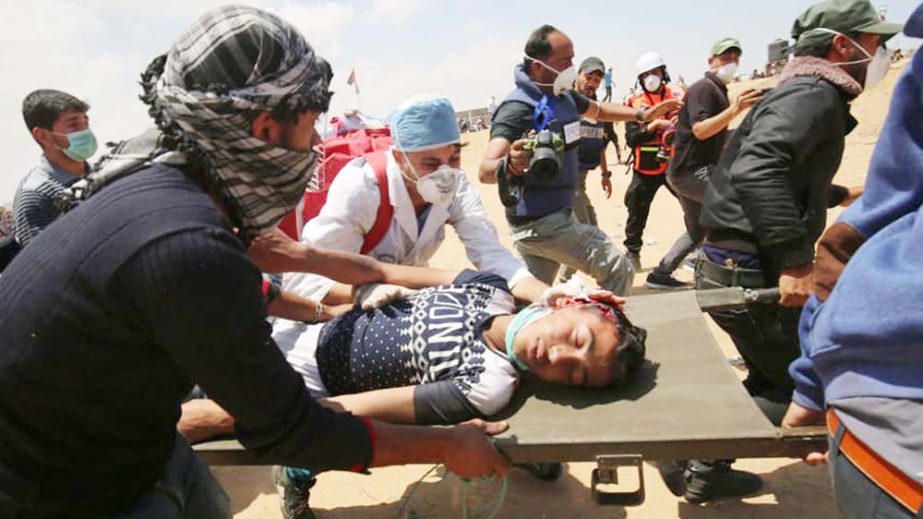
Reuters, Geneva :
United Nations investigators said on Thursday Israeli security forces may have committed war crimes over the killing of 189 Palestinians and wounding of more than 6,100 at weekly protests in Gaza last year.
“The Israeli security forces killed and maimed Palestinian demonstrators who did not pose an imminent threat of death or serious injury to others when they were shot, nor were they directly participating in hostilities,” the panel report said.
The panel had confidential information about those believed to be responsible for the killings, including snipers and commanders, which was being given to U.N. High Commissioner for Human Rights Michelle Bachelet for her to share with the International Criminal Court (ICC), it said.
Protests have been held at the frontier between Israel and the Gaza Strip since last year, calling for the easing of an Israeli blockade of the territory and recognition of the right of Palestinian refugees there to return to homes in Israel.
Israel has said its forces opened fire to protect the frontier from incursions and attacks by armed militants.
They have also demanded that the army make public the detailed list of rules, which are classified.
In its response to the petition earlier this month, however, the state did provide some insight into its “standard operating procedures.” Sfard says that is how he learned, for example, that soldiers have permission to fire on protesters breaching the border fence, even if they are unarmed and pose no imminent danger.
He has been able to piece together other bits of information about the army’s rules of engagement, he says, from public statements issued by members of the defense establishment. “Whether it’s through tweets or posts or interviews they’ve given, we know that there is authorization to use live fire against those considered ‘key agitators,’ even if these ‘key agitators’ are not endangering any lives – and that is also a violation of international standards,” Sfard says.
Even after Monday’s bloody events, which drew widespread international condemnation, the human rights lawyer does not believe the army will revisit its rules of engagement unless forced to do so by the High Court.
“This is a classic situation in which the judiciary is one of the only institutions that can do something,” Sfard says. “Diplomacy, external pressure and internal moral backbone have all failed here, and I hope the judiciary will not.”
Amnesty International, the global human rights organization, believes that the protests in Gaza, as violent as they are, should be treated as a public assembly and, therefore, subject to law enforcement rules rather than the rules of armed conflict. Its guidelines on the use of force in such situations stipulate that “in the dispersal of violent assemblies, law enforcement officials may use firearms only when less dangerous means are not practicable and only to the minimal extent necessary.”
When using force in response to violence, the guidelines urge those in charge to “distinguish between the individuals who are engaged in violence and those who are not (e.g. peaceful demonstrators or bystanders) and carefully aim such force only at those engaged in violence.”
This position is also endorsed by the International Committee of the Red Cross, which stipulated in a 2015 report on the application of international humanitarian law to contemporary armed conflicts that “if a civilian demonstration against the authorities in a situation of armed conflict were to turn violent, a resort to force in response to this would be governed by law enforcement rules.”
Dr. Eliav Lieblich, a member of the faculty of law at Tel Aviv University, is concerned that Israel has embraced “some sort of hybrid law enforcement paradigm” that permits excessive use of potentially lethal force even though it does not define the demonstrations as acts of hostility per se.
“International law, as generally understood in such cases, requires that unless somebody is a combatant on the other side, resorting to lethal force is only acceptable if that person is an imminent threat to life or limb,” says Lieblich, an expert on the legal aspects of the use of force.
“Based on an examination of the state’s submissions to the High Court, we’re seeing a widening of this perception to include also persons not directly threatening life themselves but enabling a threat to life by others – for example, through mass demonstrations. Most international lawyers would not agree.”
Prof. Amichai Cohen, a professor of international law at the Ono Academic College near Tel Aviv, says he lacks important information from the field to determine whether the army is, in fact, in violation of international law, “but the number of dead people should raise a red flag.”
He continues: “To me, it is clear – and I’m sure even the army wouldn’t deny this – that not everyone shot was intending a terror attack.”
The large casualty rate on Monday is proof, he says, that the current rules of engagement are “operationally a failure.
“You shouldn’t have these numbers, and we need to draw conclusions from this experience and try something different,” says Cohen.
In fact, on Tuesday, a senior IDF spokesman acknowledged in a briefing with North American Jews that some of the protesters had been hit by mistake and, while defending the IDF’s response, recognized that the army had failed in its attempt to minimize Palestinian casualties.

